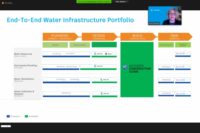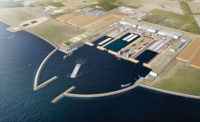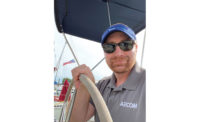
Autodesk recently agreed to acquire Innovyze, a water infrastructure modeling, simulation, and predictive analysis technology company, for $1 billion in cash. Innovyze was founded in 1996 as a subsidiary of MWH Global Inc., by Paul Boulos, then an MWH engineer. MWH was later acquired by design firm Stantec. EQT Partners bought Innovyze from Stantec for $270 million in 2017, the owner that later sold it to Autodesk. ENR recently caught up with Boulos, founder and until recently CEO of Digital Water Works Inc., to talk about the acquisition, continuing challenges of managing water infrastructure and encouraging innovation in engineering.
ENR: Congrats on the company you founded back in 1996, Innovyze, being sold for $1 billion to Autodesk. You said this was a great example of why engineering firms should invest in intrapreneurship and invent new companies to solve the problems their projects and work processes present. Can you elaborate on that?
Paul Boulos: Domain knowledge and talents may not show up on the balance sheet, but they are the most valuable assets ENR top-ranked firms possess. They’re also key drivers of new, profitable growth. As it turns out, most ENR firms—especially large ones—are actually awash in creative ideas that never get monetized or used beyond the initial project application. The surprises that lead to new business ideas often come from front-line engineers working on real projects and solving real customers’ problems.
Making it a priority to harness innovation in their work by finding better ways of doing things and proactively nurturing progress in their organizations is a clear and present opportunity. Intrapreneurship is the vehicle for bringing their innovations to life and spurring a new level of profitable growth. Intrapreneurs are employees who do for corporate innovation what an entrepreneur does for his or her start-up.
In essence, an intrapreneur acts like an innovative entrepreneur, but within the ecosystem of a larger, more traditional organization. Innovyze (initially MWH Soft) is a quintessential example of intrapreneurship success. The company parlayed a loan of $50,000 from MWH Global (now part of Stantec) into uninterrupted double-digit profitable growth, becoming the single largest contributor to MWH Global profits. What’s more, its profit-per-employee was greater than the revenue per employee of any top ENR-ranked firm.
Firms that master intrapreneurship will be able to create an unfair advantage, expand many times faster, generate stronger margins, command significantly bigger valuation multiples, and define the scope and shape of the industry’s future. They will also ring up impressive profits, revenue growth and gains in stock performance year after year, regardless of economic or industry circumstances. Just as importantly, they will become a powerful magnet for top talent—the investment that keeps on giving.
Was it rewarding to see the company you founded be sold for that much?
As chairman and CEO of Innovyze, I led the sale of the company to a private equity firm [EQT Partners] in 2017 for $270 million, a multiple record for the AEC industry. Four years later, it has broken another record. This clearly demonstrates how much that powerful intrapreneurship can accomplish.
Did you have any involvement with Innovyze after its sale by Stantec to EQT Partners in 2017?
I have always seen myself as a growth-oriented, innovation-driven leader, not a great operator. It was time for me to pioneer the development and use of digital twins within the water utility industry and usher in the new era of smart water modeling 4.0. I left after the Innovyze sale and established Digital Water Works. I subsequently sold that company to Bentley, which expanded that firm’s transformative water infrastructure digital twin (Water365) growth portfolio.
You were still working on problems involved with designing and maintaining water, wastewater and flood-control infrastructure with Digital Water Works. Do you think water modeling, analysis and engineering can make a difference for officials, planners and engineers because they have these tools, including digital twins?
The world of water infrastructure modeling, analysis and engineering has dramatically changed from on-premise static solutions to today’s cloud-based dynamic cognitive Digital Twin 4.0. That platform lets water utility staff, from finance and plant managers to engineers, planners, and field operations, gain real-time access to the data they need to do their work, and better operate, manage, and sustain their water infrastructures. It also makes it possible to share detailed information in real time, integrate and coordinate activities, and “experiment with the future” by exploring what-if scenarios, identifying potential problems, and testing out solutions safely and economically. By helping them gain operational, financial and business continuity resilience, it represents a real breakthrough in value—one that could revolutionize the way water utilities plan, manage and operate their water infrastructure systems.
Systems like Innovyze and Digital Water Works’ produce seem to be in a better place today when it comes to interoperability than they were in the past. That was always the goal to have these systems able to communicate and access data with those of companies such as Autodesk, Bentley, Esri and others, right? Was it challenging to connect the various ecosystems?
All our products at Innovyze were database-driven and able to easily share data with leading technology vendors like Autodesk, Bentley and Esri. This was a first for the industry. Digital Twins work through server-based technology and enable seamless interoperability across enterprise technologies. They represent the future across all asset-intensive industry sectors. For example, integrating them with BIM and GIS will help optimize the way all civil engineering infrastructures (e.g., buildings, facilities, roads, bridges) are managed and enable the design of more resilient infrastructure. Clearly, they put us on the cusp of a new era in business decision-making and value optimization.
The situation in Texas shows how water infrastructure needs to be better designed and maintained. We’ve seen this happen with recent floods and other situations when it looks as if there is a lot of momentum to change infrastructure regulations, but it just gets forgotten when the national news moves on to the next thing. Do you think this situation is bad enough that lawmakers and state leaders will take notice to require more resilience?
State and federal governments must prioritize investing more heavily in the nation’s water infrastructure. Flooding is one of the most common hazards in the United States, causing more damage than any other severe weather-related event. It can occur from tropical storms, hurricanes, swollen rivers, heavy rains, tidal surges, spring snowmelt, levee or dam failure, local drainage issues and water distribution main breaks. Impacts to water utilities can include loss of power, damage to assets and dangerous conditions for personnel. As storms become more frequent and intense, and as sea levels rise, flooding will be an ongoing challenge for these utilities.
Water utilities are building resilience by implementing mitigation measures such as emergency response plans, equipment modifications or upgrades, or new capital investment/construction projects. The Environmental Protection Agency provides tools to increase water utilities’ preparedness for and resilience in flooding emergencies. The Federal Emergency Management Agency provides maps showing areas that will be affected by flooding. They can be used to understand the threats and to devise hazard mitigation plans (including possible projects) to mitigate their effects. To help pay for flood-mitigation measures, water utilities can also apply for federal disaster mitigation funds.






Post a comment to this article
Report Abusive Comment